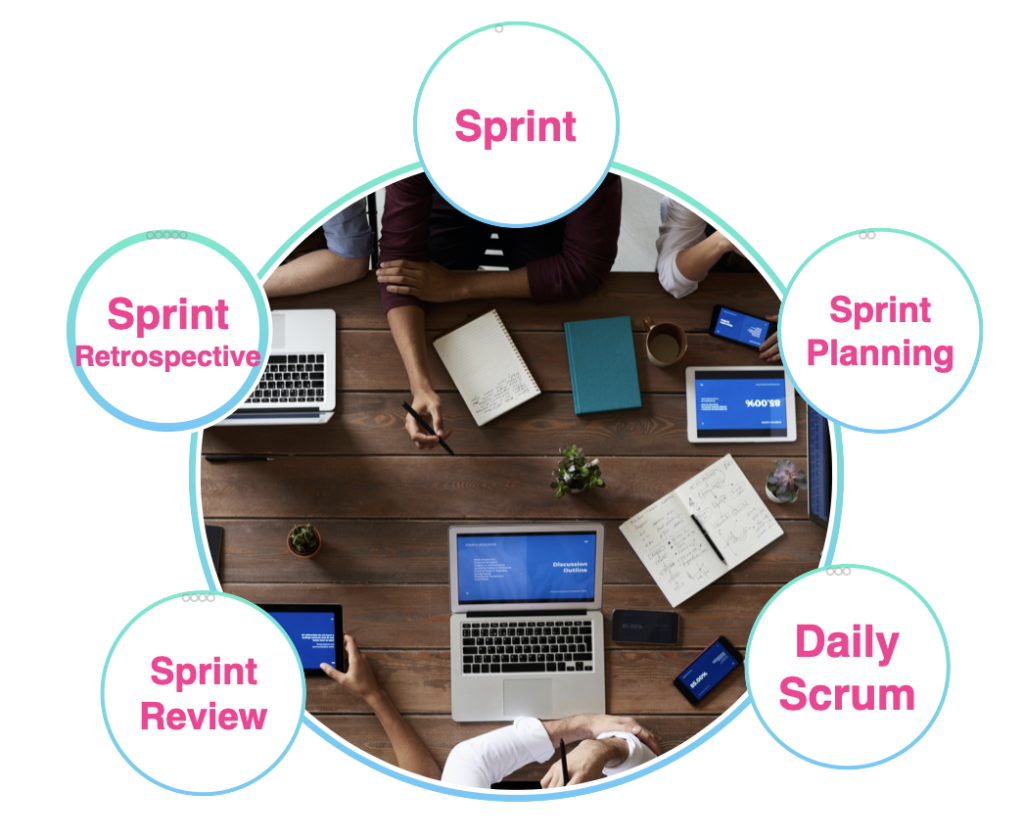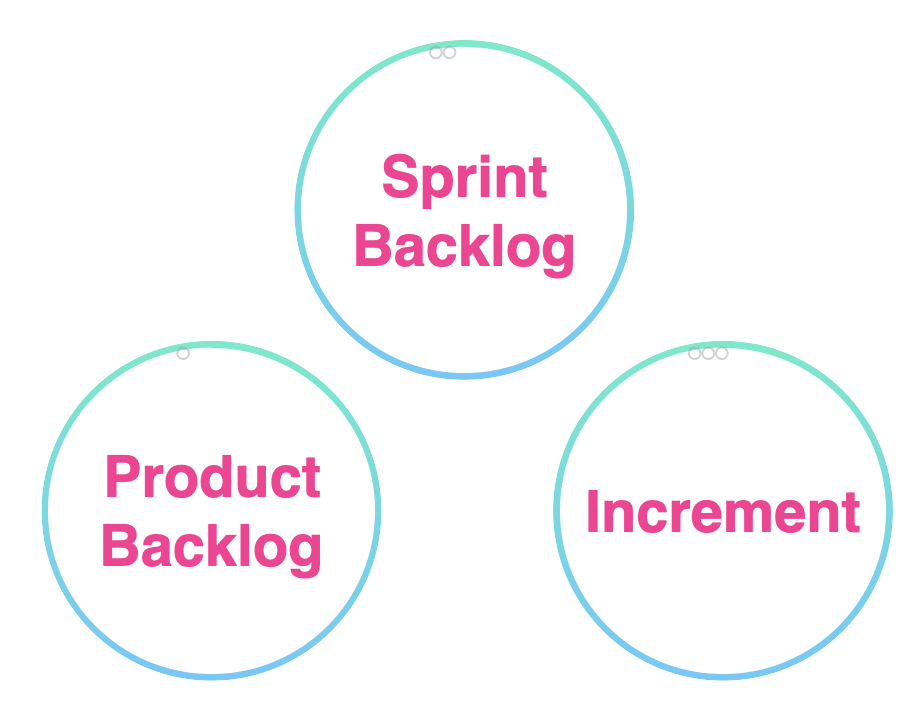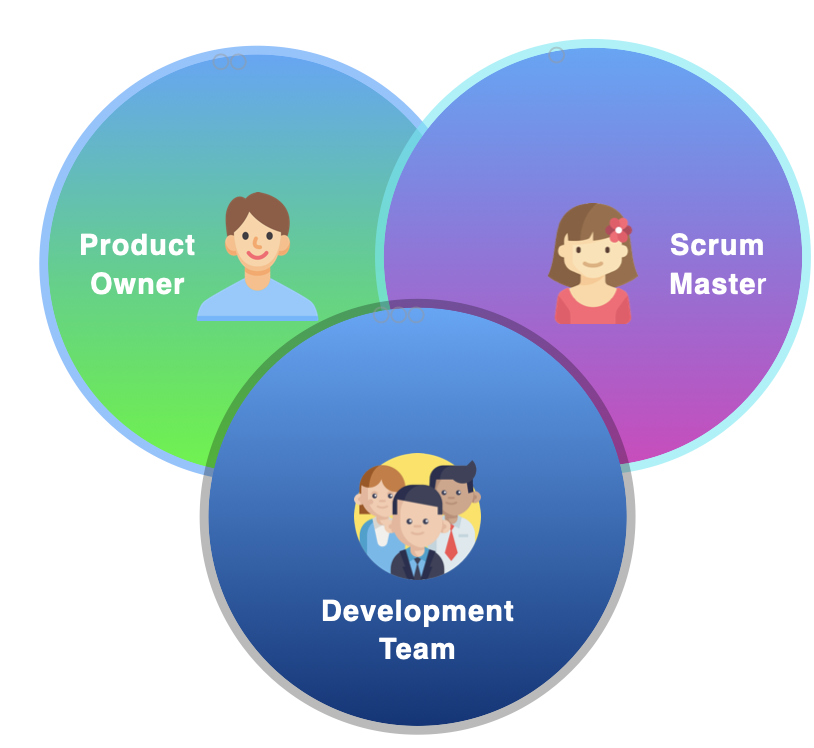Scrum is an Agile framework for managing projects and product development. It is a process that helps teams work together to deliver a product or service in a collaborative and flexible way. The Scrum framework was first introduced in the early 1990s by Jeff Sutherland, and has since become one of the most widely-used Agile methodologies in the world.
Events
The five events in Scrum are Sprint Planning, Daily Scrum, Sprint Review, Sprint Retrospective, and Backlog Refinement.
-
- Sprint Planning is an event where the team plans the sprint and decides which product backlog items they will work on during the sprint.
- The Daily Scrum is a daily event where the team meets to discuss the progress of the sprint and to plan the work for the next 24 hours.
- The Sprint Review is an event where the team reviews the progress of the sprint and demonstrates the product increment to the stakeholders.
- The Sprint Retrospective is an event where the team reflects on the sprint and identifies ways to improve in the next sprint.
- Backlog Refinement is an event where the team reviews and updates the product backlog.


Artifacts
The three artifacts in Scrum are the Product Backlog, the Sprint Backlog, and the Increment.
-
- The Product Backlog is a list of all the items that need to be delivered in order to complete the product or service. It is owned by the Product Owner and is prioritized based on the value that each item will deliver.
- The Sprint Backlog is a list of all the items that the team has committed to delivering in the current sprint. It is owned by the Development Team.
- The Increment is the sum of all the product backlog items that have been completed during the sprint. It is a potentially releasable product that can be delivered to customers.
Benefits of Scrum
Scrum provides many benefits to teams and organizations. Some of the most notable benefits include:
-
- Increased flexibility and adaptability: Scrum enables teams to respond quickly to changes in the market or customer needs, which is especially important in today’s fast-paced business environment.
- Improved collaboration and communication: Scrum promotes a collaborative and transparent working environment, which helps teams to work together more effectively.
- Increased visibility and predictability: Scrum provides clear visibility into the progress of the project, which helps stakeholders to understand the status of the project and to make better-informed decisions.
- Increased productivity and quality: Scrum helps teams to deliver a potentially releasable product increment at the end of each sprint
Scrum is a framework that is based on the principles of Agile software development. It is designed to help teams work together to deliver a product or service in a collaborative and flexible way. Scrum is made up of three roles, five events, and three artifacts.
[/vc_column_text][/vc_column][/vc_row]

Roles
The three roles in Scrum are the Product Owner, the Scrum Master, and the Development Team.
-
- The Product Owner is responsible for defining the product backlog and prioritizing the items in it. They are also responsible for ensuring that the team is working on the most valuable items at all times.
- The Scrum Master is responsible for facilitating the Scrum process and helping the team to work together effectively. They also help the team to remove any obstacles that are preventing them from working efficiently.
- The Development Team is responsible for delivering a potentially releasable product increment at the end of each sprint. They are also responsible for planning and executing the sprint, as well as for estimating the size of the product backlog items.
Events
The five events in Scrum are Sprint Planning, Daily Scrum, Sprint Review, Sprint Retrospective, and Backlog Refinement.
-
- Sprint Planning is an event where the team plans the sprint and decides which product backlog items they will work on during the sprint.
- The Daily Scrum is a daily event where the team meets to discuss the progress of the sprint and to plan the work for the next 24 hours.
- The Sprint Review is an event where the team reviews the progress of the sprint and demonstrates the product increment to the stakeholders.
- The Sprint Retrospective is an event where the team reflects on the sprint and identifies ways to improve in the next sprint.
- Backlog Refinement is an event where the team reviews and updates the product backlog.


Artifacts
The three artifacts in Scrum are the Product Backlog, the Sprint Backlog, and the Increment.
-
- The Product Backlog is a list of all the items that need to be delivered in order to complete the product or service. It is owned by the Product Owner and is prioritized based on the value that each item will deliver.
- The Sprint Backlog is a list of all the items that the team has committed to delivering in the current sprint. It is owned by the Development Team.
- The Increment is the sum of all the product backlog items that have been completed during the sprint. It is a potentially releasable product that can be delivered to customers.
Benefits of Scrum
Scrum provides many benefits to teams and organizations. Some of the most notable benefits include:
-
- Increased flexibility and adaptability: Scrum enables teams to respond quickly to changes in the market or customer needs, which is especially important in today’s fast-paced business environment.
- Improved collaboration and communication: Scrum promotes a collaborative and transparent working environment, which helps teams to work together more effectively.
- Increased visibility and predictability: Scrum provides clear visibility into the progress of the project, which helps stakeholders to understand the status of the project and to make better-informed decisions.
- Increased productivity and quality: Scrum helps teams to deliver a potentially releasable product increment at the end of each sprint
What is Scrum?
Scrum is a framework that is based on the principles of Agile software development. It is designed to help teams work together to deliver a product or service in a collaborative and flexible way. Scrum is made up of three roles, five events, and three artifacts.
[/vc_column_text][/vc_column][/vc_row]

Roles
The three roles in Scrum are the Product Owner, the Scrum Master, and the Development Team.
-
- The Product Owner is responsible for defining the product backlog and prioritizing the items in it. They are also responsible for ensuring that the team is working on the most valuable items at all times.
- The Scrum Master is responsible for facilitating the Scrum process and helping the team to work together effectively. They also help the team to remove any obstacles that are preventing them from working efficiently.
- The Development Team is responsible for delivering a potentially releasable product increment at the end of each sprint. They are also responsible for planning and executing the sprint, as well as for estimating the size of the product backlog items.
Events
The five events in Scrum are Sprint Planning, Daily Scrum, Sprint Review, Sprint Retrospective, and Backlog Refinement.
-
- Sprint Planning is an event where the team plans the sprint and decides which product backlog items they will work on during the sprint.
- The Daily Scrum is a daily event where the team meets to discuss the progress of the sprint and to plan the work for the next 24 hours.
- The Sprint Review is an event where the team reviews the progress of the sprint and demonstrates the product increment to the stakeholders.
- The Sprint Retrospective is an event where the team reflects on the sprint and identifies ways to improve in the next sprint.
- Backlog Refinement is an event where the team reviews and updates the product backlog.


Artifacts
The three artifacts in Scrum are the Product Backlog, the Sprint Backlog, and the Increment.
-
- The Product Backlog is a list of all the items that need to be delivered in order to complete the product or service. It is owned by the Product Owner and is prioritized based on the value that each item will deliver.
- The Sprint Backlog is a list of all the items that the team has committed to delivering in the current sprint. It is owned by the Development Team.
- The Increment is the sum of all the product backlog items that have been completed during the sprint. It is a potentially releasable product that can be delivered to customers.
Benefits of Scrum
Scrum provides many benefits to teams and organizations. Some of the most notable benefits include:
-
- Increased flexibility and adaptability: Scrum enables teams to respond quickly to changes in the market or customer needs, which is especially important in today’s fast-paced business environment.
- Improved collaboration and communication: Scrum promotes a collaborative and transparent working environment, which helps teams to work together more effectively.
- Increased visibility and predictability: Scrum provides clear visibility into the progress of the project, which helps stakeholders to understand the status of the project and to make better-informed decisions.
- Increased productivity and quality: Scrum helps teams to deliver a potentially releasable product increment at the end of each sprint






